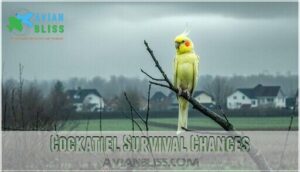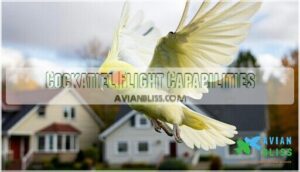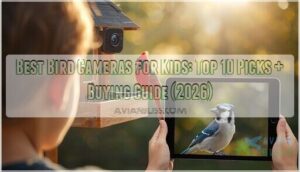This site is supported by our readers. We may earn a commission, at no cost to you, if you purchase through links.
 Don’t panic if your cockatiel flew away – these intelligent birds often stay within a few blocks of home.
Don’t panic if your cockatiel flew away – these intelligent birds often stay within a few blocks of home.
Act quickly by staying calm and searching the immediate area while calling your bird’s name in a reassuring voice. Check trees, rooftops, and neighbors’ yards first, as cockatiels typically fly upward when startled.
Listen for their distinctive calls and whistles. Set their cage outside with favorite treats and familiar toys to attract them back.
Contact neighbors immediately and post on local social media groups with your bird’s photo. Many lost cockatiels return within 24-48 hours when owners take swift, organized action using the right recovery techniques.
Table Of Contents
- Key Takeaways
- Cockatiel Flight Response
- Why Cockatiels Fly Away
- Preventing Cockatiel Escape
- Finding Lost Cockatiels
- Cockatiel Survival Chances
- Luring Back Lost Cockatiels
- Cockatiel Flight Capabilities
- Recovery and Reunion
- Frequently Asked Questions (FAQs)
- How to catch an escaped cockatiel?
- Can a cockatiel come back home?
- What do cockatiels do when they escape?
- What are the odds of finding a lost cockatiel?
- What happens if my cockatiel flies away?
- Can a pet cockatiel survive in the wild?
- How to find your lost cockatiel?
- How do I find a lost cockatiel?
- What if my cockatiel doesnt return?
- How far can a cockatiel fly?
- Conclusion
Key Takeaways
- Act immediately and stay calm – Most escaped cockatiels remain within 2 miles during the first 24 hours, so you’ll have the best chance of recovery if you start searching right away without panicking.
- Search systematically while calling their name – Check nearby trees, rooftops, and high perches first since cockatiels fly upward when startled, and use familiar sounds like their name or favorite phrases to help them locate you.
- Use their cage and treats as bait – Place their cage outside with the door open along with their favorite treats and toys to create a familiar environment that’ll attract them back home.
- Get your community involved quickly – Alert neighbors, post on local social media groups with your bird’s photo, and contact animal shelters since community support dramatically increases your chances of a successful reunion.
Cockatiel Flight Response
When your cockatiel flies away, your heart races and panic sets in, but staying calm is essential for a successful rescue.
A calm mind and quick action are your cockatiel’s best hope for coming home.
You need to act immediately because most escaped cockatiels remain within a 2-mile radius during the first 24 hours, giving you the best chance to bring your feathered friend home safely.
Stay Calm and Act Fast
When your cockatiel escaped, take a deep breath and focus on clear thinking.
Panic clouds judgment, but a quick response with effective planning increases recovery chances dramatically.
Start your immediate search within minutes—80% of lost birds stay within two miles initially.
Your calm communication and systematic approach during these critical first moments can mean the difference between a successful bird recovery and a prolonged search for your missing pet, which relies on effective planning.
Search Immediate Area
Start your search close to home, scanning nearby poles and trees within a 360-degree radius. Your cockatiel escaped but likely hasn’t flown far—most stay within two miles initially.
Search close to home first—your escaped cockatiel is likely hiding within two miles of familiar territory.
Put on bright clothes to make yourself visible while moving systematically through your neighborhood. Use a flashlight search during evening hours to spot reflective eyes.
Speak in a soothing voice as you check each potential perch. Eyesight monitoring advantages help birds detect threats.
Call Out Bird’s Name
Once you’ve covered the nearby area, your voice becomes your most powerful tool. Call out your cockatiel’s name using recognizable tones and familiar phrases—birds hearing is sharp, and vocalization effectiveness increases dramatically when you use sounds they know. Tone matters more than volume, so keep your voice calm yet clear. Response recognition helps your bird locate you through the chaos.
Here’s how to maximize your calling strategy:
- Repeat their favorite phrases – Use the words that always made them perk up in their cage
- Whistle their special tune – That melody you shared during bonding time could guide them home
- Call their name every 30 seconds – Consistent call frequency helps them triangulate your location
Your search strategies should include moving while calling, as sound travels differently through neighborhoods. Don’t just stand in one spot—walk the search neighborhood while maintaining steady vocalizations.
Why Cockatiels Fly Away
Understanding why your cockatiel flew away helps prevent future escapes and improves your search strategy.
Most cockatiels escape due to instinctual flight responses triggered by sudden noises, open doors or windows left unattended, or fear reactions during unsupervised time outside their cage, which can be prevented by understanding the causes of such escapes.
Instinctual Behavior
When you’re faced with a missing cockatiel, understanding their instinctual behavior helps predict where they’ve gone.
Their survival instincts kick in immediately, triggering flock mentality that makes them seek other birds or high perches.
Homing instincts vary among individual cockatiels, while foraging behavior drives them toward food sources.
These deeply ingrained avian behavior patterns influence their flight path and hiding spots during escape situations.
Fear or Startle Response
A sudden noise or unexpected movement can trigger your cockatiel’s natural fright response, causing immediate avian escape.
Loud sounds, quick gestures, or unfamiliar objects create perceived threats that activate their flight instinct.
When cockatiels experience fear response from environmental changes or poor handling techniques, they’ll flee without thinking.
Watch for behavioral indicators like raised crests or wide eyes—these warn you before your cockatiel flew away becomes reality.
Open Doors or Windows
Most cockatiels flew away through accidental escape routes you mightn’t notice. Open doors create instant flight paths when your bird feels startled or curious.
Unsecured windows and damaged screens offer easy exits during free-roam time. Check door awareness before letting your cockatiel out – even briefly opened doors pose risks.
Maintain screen integrity and window security as essential prevention tips for escape prevention.
Lack of Supervision
During unsupervised playtime, your cockatiel can easily slip through open doors or windows before you realize what’s happening.
This negligence has serious consequences when pet bird escape occurs. Owner responsibility includes maintaining environmental awareness and ensuring supervised playtime prevents these accidents.
To combat boredom, consider essential toys and accessories for mental and physical stimulation. Implementing preventative measures like checking exits before freetime keeps your feathered friend safe at home with supervised playtime.
Preventing Cockatiel Escape
You can prevent most cockatiel escapes by taking simple safety steps before they happen.
Creating a secure environment and staying alert during playtime will keep your feathered friend safely at home.
Secure Home Environment
Creating a secure environment starts with checking every potential escape route in your home.
Always close windows and doors before letting your cockatiel out for supervised roaming. Check your bird cage for damaged bars or loose latches that compromise cage integrity.
A cage with proper bar spacing is essential for preventing escapes.
Secure screens on windows for window safety, and install childproof locks on doors for door security. These flight prevention measures create the foundation for keeping your feathered friend safely home.
Supervise Outdoor Play
When you take your cockatiel outdoors, weather awareness becomes your top priority to prevent escape.
Flight risks multiply quickly without proper supervision, turning a fun outing into a nightmare scenario where your cockatiel flew away.
Many owners find harnesses aid in safety.
- Harness training – Start indoors with short sessions to build comfort
- Weather awareness – Avoid windy days that can disorient your bird
- Predator threats – Watch for cats, hawks, and other dangers nearby
- Safe zones – Choose enclosed patios or screened areas when possible
- Constant supervision – Never leave your bird unattended, even briefly
Provide Mental Stimulation
Boredom breeds escape attempts, so keeping your cockatiel mentally engaged prevents wandering thoughts about the great outdoors.
Interactive toys, foraging opportunities, and training techniques satisfy their curious nature while strengthening your bond through social interaction.
| Enrichment Activities | Benefits | Implementation |
|---|---|---|
| Puzzle feeders | Mimics natural foraging | Hide treats in paper cups |
| Mirror play | Provides social stimulation | Rotate mirrors weekly |
| Music sessions | Reduces stress and anxiety | Play varied genres daily |
| Teaching tricks | Builds mental focus | Start with simple commands |
| Rotating toy collection | Prevents habituation | Switch toys every few days |
Finding Lost Cockatiels
When your cockatiel escapes, every minute counts because 80% of lost birds stay within a 2-mile radius during the first 24 hours.
You’ll need to act quickly and search systematically to maximize your chances of bringing your feathered friend home safely.
Take Immediate Action
The moment you realize your cockatiel flew away, your heart starts racing.
Don’t panic – staying calm helps you think clearly and act fast.
Your bird is likely still nearby, so start your search efforts immediately.
Walk around calling your cockatiel’s name while listening carefully for responses.
Play familiar music outside to catch their attention, and use a flashlight if it’s getting dark to spot movement, which can help you act fast.
Search Neighborhood
Expand your search radius systematically as time passes.
Start with a three-block perimeter, then widen to cover local shelters and public parks where cockatiels often seek refuge.
Night searches prove valuable—use flashlights to spot reflective eyes in trees.
Communicate urgency to anyone you encounter, explaining your lost cockatiel situation.
Effective cockatiel search methods involve persistent community involvement throughout the neighborhood.
Inform Neighbors
Rally your neighbors immediately—they’re your best allies in this search mission.
Knock on doors, share photos, and ask them to keep their eyes peeled for your lost bird.
Create simple flyers with clear contact info and your cockatiel’s picture for wider neighborhood search coverage.
Alert local shelters about your missing bird, as they often receive calls about found pets.
Community alerts work wonders when everyone knows you’re searching for your lost cockatiel, and having local support can be very helpful, especially with immediate action.
Cockatiel Survival Chances
When your cockatiel escapes, understanding survival odds helps you plan your search strategy effectively.
Your bird faces real challenges from weather, predators, and finding food, but many cockatiels do survive and return home with proper search efforts.
Environmental Factors
Weather conditions dramatically impact your cockatiel’s survival chances.
Cold temperatures below 50°F pose serious threats, while heat waves cause dehydration.
Predator threats from hawks and cats increase in urban areas.
Food scarcity becomes critical after five days.
Your bird’s resourcefulness in finding water sources within 36 hours often determines survival.
Distance and time since escape directly affect environmental factors and habitat influence on recovery odds.
They’re native to the Australian mainland and prefer open woodland habitats.
Food and Water Availability
Your lost cockatiel’s survival chances depend heavily on finding adequate Wild Food Sources and Hydration Strategies. Cockatiels need both food and water daily, making Nutritional Needs critical for bird survival.
Scarcity Impact increases dramatically after five days without proper nutrition, affecting cockatiel survival rates substantially.
Finding Water and food sources include:
- Bird feeders and backyard seed spills
- Garden fruits, berries, and dandelion weeds
- Puddles, sprinklers, and birdbaths for hydration
- Outdoor café crumbs and playground debris
Predator Avoidance
Beyond water concerns, your cockatiel faces serious predator threats that dramatically impact survival odds.
Hawks, falcons, and domestic cats pose the greatest danger, causing 65% of urban cockatiel casualties.
Your bird’s natural camouflage techniques and erratic flight patterns help avoid aerial predators, while audible alarms warn of ground threats.
| Predator Type | Risk Level & Defense Strategy |
|---|---|
| Hawks/Falcons | High – Zigzag flight patterns, seek dense cover |
| Domestic Cats | Extreme – Freeze-and-flee tactics, high perching |
| Urban Wildlife | Moderate – Group defense calls, habitat selection |
| Corvids (Crows) | Medium – Collective alarm responses, foliage hiding |
| Ground Predators | Variable – Vertical takeoffs, tree hollow refuge |
Luring Back Lost Cockatiels
Once you spot your cockatiel, use familiar sounds like their name, favorite songs, or your voice to encourage them to come closer.
Bring their cage outside with the door open and place their favorite treats nearby to create a welcoming environment that feels like home.
Use Familiar Sounds
Your lost cockatiel recognizes your voice better than any stranger’s call.
Start with their name, then whistle their favorite tunes or phrases they’ve learned. Sound Recognition helps them locate you from surprising distances.
Many owners find success playing recorded cockatiel calls or familiar household sounds like opening treat containers.
Audio Range matters – your cockatiel behavior responds to consistent, calm vocalizations rather than frantic shouting during cockatiel search efforts, which can be aided by consistent calls.
Bring Cage Near Bird
Bringing your lost cockatiel’s cage near its location creates instant familiarity and comfort.
Position the cage where you spotted your bird, ensuring it’s visible as a visual cue for cockatiel rescue efforts.
This cage familiarity helps during cockatiel search missions because location matters – your pet bird missing will recognize home.
Consider using a collapsible travel cage for easy transport.
The familiar environment encourages your cockatiel found to approach safely.
Offer Treats
Place your cockatiel’s favorite treat near the cage to create an irresistible lure. Fresh treats work better than stale options for attracting a lost cockatiel.
Offer treat variety like millet, sunflower seeds, or fruit pieces in visible spots. Only use safe treats your bird recognizes.
Strategic treat placement along your bird’s likely flight path can guide cockatiel return efforts during cockatiel escape situations.
Cockatiel Flight Capabilities
Understanding your cockatiel’s flight abilities helps you predict where they might go and how far they can travel.
While wild cockatiels can fly up to 30 miles daily at speeds of 40 mph, your domesticated bird likely has limited flight endurance due to reduced wing strength from cage life.
Speed and Distance
When your cockatiel escapes, understanding their flight capabilities helps predict where they’ll go.
These agile birds reach speeds up to 43 mph with impressive flight endurance, though most escaped cockatiels fly in short bursts rather than sustained distances.
Wild cockatiels cover up to 30 miles daily, but your pet’s typical range stays much closer—usually within two miles during those vital first 24 hours.
Cockatiels’ agility allows them to achieve impressive flight speeds, reaching up to 54 kph.
Domesticated Limitations
While your pet bird might seem like a natural flyer, captivity effects have substantially reduced their survival skills.
Years of comfortable living mean your lost cockatiel lacks the endurance and foraging abilities their wild cousins possess.
Your domesticated bird faces these challenges:
- Limited foraging experience makes finding food difficult
- Reduced endurance from lack of regular long-distance flying
- Social dependency on humans for basic needs
- Instinct suppression from generations of captive breeding
When your bird flew away, they’re basically traversing with a roadmap they’ve never learned to read.
Navigation Skills
Unlike their wild cousins who master complex flight patterns across vast territories, your escaped cockatiel faces significant navigation challenges.
Pet birds lack developed homing instincts and spatial memory needed for long-distance travel. They rely heavily on environmental cues and familiar sounds rather than innate behavioral instincts.
Most domesticated cockatiels can’t judge distance accurately, making their sense of direction unreliable beyond short ranges, which is due to their reliance on environmental cues rather than innate behavioral instincts and lack of spatial memory.
Recovery and Reunion
Getting the community involved can dramatically increase your chances of bringing your feathered friend home safely.
Social media posts and neighborhood alerts create a network of eyes watching for your cockatiel, turning what feels like an impossible search into a coordinated rescue mission.
Community Involvement
Your bird’s flight capabilities mean nothing without community support rallying behind you.
Getting neighbors involved transforms a solo search into a neighborhood mission that dramatically increases your chances of success.
- Inform Neighbors – Knock on doors within a 2-mile radius with your bird’s photo and description
- Distribute Flyers – Post clear, eye-catching notices at mailboxes, community boards, and local businesses
- Online Alerts – Share on neighborhood apps like Nextdoor and Facebook community groups immediately
- Local Shelters – Contact animal shelters and bird rescue organizations within 20 miles of your location
- Media Outreach – Reach out to local radio stations and newspapers for lost pet announcements
Posting Alerts
Reach out beyond your neighborhood by creating eye-catching flyers with clear photos and your contact information.
Post these in local pet stores, veterinary clinics, and community centers where bird lovers gather.
Don’t forget online forums and social media alerts – the bird community actively shares missing pet posts.
Many lost cockatiel cases find success through online communities and local shelters checking their networks.
Consider using professionally designed lost bird posters to increase visibility.
Many lost cockatiel cases find success through online communities and local shelters checking their networks.
Utilizing Social Media
Social media amplifies your search efforts beyond neighborhood boundaries.
Create posts with clear photos and your bird’s details on Facebook, Twitter, and Instagram. Join local lost pet groups and targeted bird communities for focused help.
Use hashtags like #lostcockatiel and your city name to increase visibility. Consider boosting posts with social media ads for wider reach.
Online communities often share rapidly, turning your search into a viral cockatiel post that brings your feathered friend home, thanks to the power of social media.
Frequently Asked Questions (FAQs)
How to catch an escaped cockatiel?
Stay calm and act quickly. Place your bird’s cage outside with favorite treats and play familiar music. Search nearby trees while calling their name in soothing tones. Alert neighbors immediately.
Can a cockatiel come back home?
Like Max, who returned after three days hiding in a neighbor’s oak tree, your cockatiel can definitely come back home.
Yes, they can return – their strong homing instincts and bond with you motivate them to find their way back, especially within the first 72 hours.
What do cockatiels do when they escape?
When your cockatiel escapes, it’ll likely perch nearby in trees, feeling scared and disoriented. Most hide within two miles, calling back if they hear familiar voices or sounds.
What are the odds of finding a lost cockatiel?
Time’s your friend when searching for your missing feathered companion.
You’ll have roughly 80% odds of reuniting within a 2-mile radius during the first vital 24 hours if you act quickly and persistently.
What happens if my cockatiel flies away?
When your bird escapes, act immediately.
Search nearby trees while calling their name loudly. Place their cage outside with food and water.
Most cockatiels stay within two miles initially and can survive if they find resources.
Can a pet cockatiel survive in the wild?
Your escaped cockatiel can survive in the wild, but it’s challenging. They’ll struggle finding food, avoiding predators, and handling weather changes without your care and protection.
How to find your lost cockatiel?
Like searching for a needle in a haystack, don’t panic—act quickly.
Search nearby trees immediately while calling your cockatiel’s name loudly.
Place their cage outside with treats and familiar sounds to guide them home safely.
How do I find a lost cockatiel?
Act quickly—your cockatiel’s likely nearby!
Search immediately, calling its name loudly.
Place its cage outside with food.
Check trees, poles, and high perches first.
Alert neighbors and post on social media to alert others.
What if my cockatiel doesnt return?
If your cockatiel doesn’t return despite persistent efforts, consider expanding your search radius beyond two miles.
Post on social media, contact local animal shelters, and don’t give up hope—some cockatiels return after weeks.
How far can a cockatiel fly?
Wild cockatiels can fly up to 30 miles daily at speeds reaching 43 mph.
Your escaped cockatiel likely won’t travel that far since domesticated birds tire quickly without regular flight practice and typically stay within two miles, making domesticated a key factor.
Conclusion
Like a beacon guiding ships home through stormy waters, your quick response when your cockatiel flew away can make all the difference.
Stay calm, search systematically, and use familiar sounds to draw them back.
Most escaped cockatiels return within 48 hours when you act fast and involve your community.
Keep their cage visible, post on social media, and don’t lose hope, with persistence and the right approach, you’ll likely welcome your feathered friend home soon, and this is a matter of acting fast.















Linda
February 10, 2025 at 05:11 AM
my male cockatiel has been lost a year and 4 mos-never returned and another one 3 yrs lost jan 16 this yr he has 1 yr old brother waiting for him destiny and speckles-kiwi his brother bought them from breeder when my other bird didnt return.Im heartbroken and trauma set in cried alot when second bird left travel cage outside i took them both